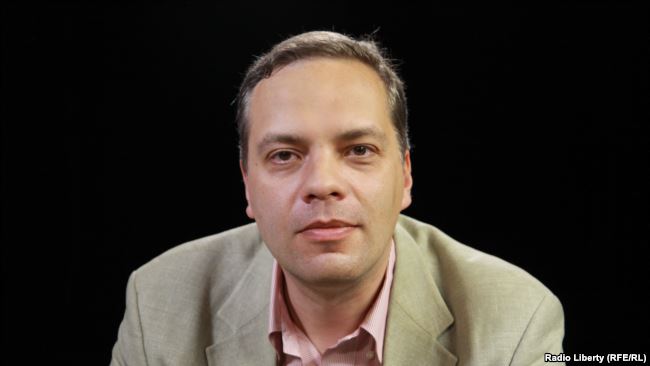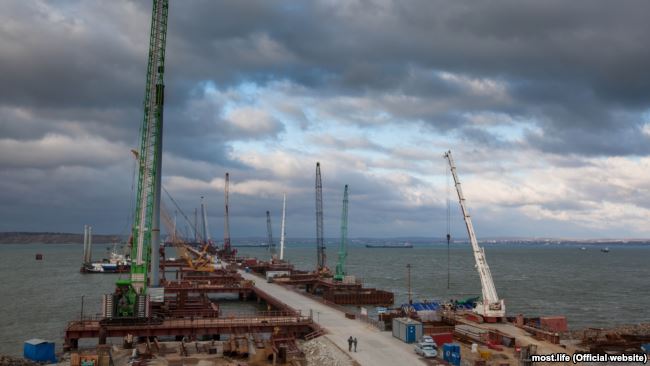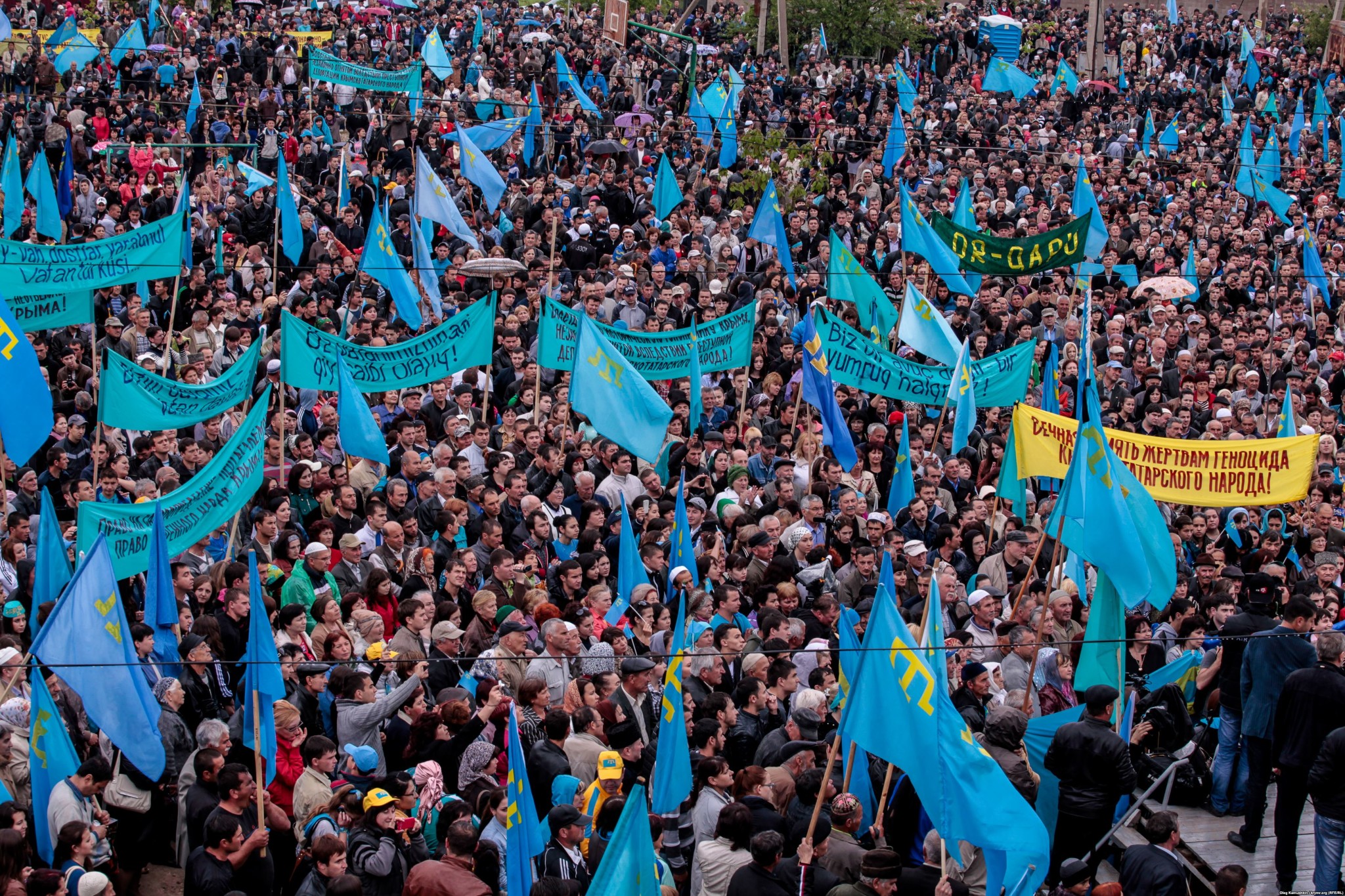asked the Russian opposition politician, economist and public figure, Vladimir Milov, whether Moscow has it in its power to resolve these problems, and how much the annexed territory may cost Russians.

Vladimir, regarding Crimean problems one should perhaps start with the issue of fresh water. As far as we know, the problems are being aggravated as, according to local residents, the [new-coming] settlers [from Russia - Ed.] irrigate crops with it [groundwater - Ed], leading to the salinization of groundwater. What should be done to solve this problem, and how much will it cost?
Water supplies are insufficient for normal life in Crimea. There is no solution to the problem without the normalization of relations with mainland Ukraine.
It is important to understand that Crimea's water problem basically has no solution. The only systemic solution was the North Crimean Canal [to mainland Ukraine - Ed.], yet its restoration in the near future is not expected to happen. Crimea does not have the resources to provide for its own water needs. There is no river network as rainfall totals are low. The North Crimean Canal provided up to 80% of the peninsula’s water requirements.
Now, the Russian authorities are trying to “plug holes,” but in reality this will only lead to the problems worsening in a couple of years. You correctly said that the sharp intensification of groundwater drilling will lead to accelerated water mineralization and make it unusable. Also, the Russian authorities are trying to maximise the use of the Belgorsky reservoir. But this is all fraught with the danger of critically depleting reserves. I repeat: there is not enough water to maintain normal life and industrial and agricultural activity in Crimea, and there is no solution to this problem without normalising relations with mainland Ukraine.

Of course, there is another option which is used, for example, by Mediterranean countries similar to Crimea in terms of low water quality, such as Israel or Cyprus. They are following the route of building sea water desalination plants. However, this is a very expensive procedure: in relative terms, one million dollars investment for a capacity of one thousand cubic metres of water per day.
That means, to cover the losses incurred due to the closure of the North Crimean Canal, it would be necessary to invest 4-5 billion dollars. In comparison, this is approximately the annual expenditure on health care in Russia. If we add the various “surcharges” and bribes for those who will certainly want to earn on this, it will cost even more.
If the Russian authorities wish to follow this path, they will of course be able to find the money, taking it from pensioners and working Russians, raising taxes and cutting social expenditures. Russia does not save on geopolitics; they only save on people. Or they will carry on in predatory form, exploiting underground water reserves and the few available reservoirs, finally destroying Crimea’s ecosystem and economic prospects. For Putin and his administration, this style is familiar: squeeze out more today, as it will only be grass left unable to grow tomorrow.Russia does not save on geopolitics, they only save on people
There is also the electricity problem. Do you think that Putin’s “energy bridges” are able to resolve it?
The situation is similar to that of water. The whole energy supply system in Crimea was set up to work through Ukraine’s system. The main energy supply routes come from the north, from Ukraine, and serve the more developed western part of Crimea. Yes, now a lot of noise has been made about the energy bridge to Crimea, but in reality it enters the town of Kerch, located in the extreme east of the peninsula, far from the main economic centres and southern coast. Thus it will be necessary to stretch additional power lines to supply electricity from Russia to the west and south of Crimea. The current flow of electricity is simply inadequate.
So the real reason for this is not that claimed by the Russian authorities. The energy bridge is rather a psychological device to show the inhabitants of the peninsula that Russia cares about them. Their main plan is a gas pipeline from the Kuban which would have a capacity of up to four billion cubic metres of gas per year, which would supply gas for the modernised CHP plants, primarily for the four power units of the Simferopol and Sevastopol TPPs with a total capacity of almost 1,000 megawatts. The costs of construction are estimated at RUB 70 bn ($1.2 bn), and the gas pipeline - RUB 20 bn ($337 mn). I am however sure that during construction, as always happens in Russia, the estimate will only rise.
The contractors there are all the same. Construction of the Kuban-Crimea gas pipeline was carried out by Arkady Rotenberg’s Stroigazmontazh
; the power plant is being built by Sergei Chemezov’s Tekhnopromexport (part of Rostek) – all of these people are familiar faces in Putin’s entourage. All of them will earn nicely in Crimea. Yet it will be Russians and Crimean consumers who will eventually have to pay. Crimeans need not expect cheap electricity or gas, given that the huge investments will have to be recouped. At the same time, it is funny that officials refused to name the source of finance for the main gas pipeline to Crimea.
By the way, according to Rosstat statistics, prices in Crimea have now doubled compared to December 2013, with salaries only 30-40% up. Even official statistics indicate that inflation in Crimea is much higher than in Russia itself.
Local people also talk of Crimea being settled by newcomers from Russia. The construction of new housing – this is also a weight on the budget. Why is this being undertaken?
Here, we have two aspects: civil and military housing construction. The Russian Defence Ministry recently disclosed that it has allocated RUB 6 bn ($101 mn) for the construction of housing for servicemen. The programme for civil housing construction, approved by the Crimean government for the period of 2017 to 2020, provides for the construction of more than half a million square metres of housing, estimated to cost RUB 22 bn ($371 mn). The overwhelming majority of the money will come out of the Crimean budget, yet this is subsidised to the tune of 75% from Russia. So it is again Russian taxpayers’ money. In general, impressive sums of money are being invested in Crimea, about RUB 200 bn ($3.4 bn) for various projects. This is more than half the amount of federal spending on health, for example.The amount of Russia's investments in Crimea totals more than half the amount of federal spending on healthcare
I know that other regions with huge problems have had their funding cut by the center, and simply grit their teeth. But nobody may object, because everyone understands that the patriotic frenzy and Putin’s Crimean policy is a sore spot best left alone. And this is just the tip of the iceberg: huge sums of money come out of extra-budgetary sources, and these costs are ultimately paid by Russian consumers one way or another via prices and tariffs.
There are many signs of Crimea being converted from a tourist resort into a military base. How much has the Russian budget lost from this, and what may the consequences of such a conversion be?
Frankly, I do not see much direct risk to the tourist industry from the militarisation of Crimea, since military units are mostly concentrated at traditional military bases mostly far from traditional resorts, for example cities such as Sevastopol or Belbek. On the whole, however, the region’s militarisation does carry great risks. In practice, there is no need for it: Russia should pursue a policy of further reducing the level of tension in the Black Sea basin, instead of turning the peaceful region into an arena of military confrontation for no reason.
Of course, this is not attractive to tourists – people prefer to travel to quiet regions, but I still say that for the tourist industry all this is not very important. Its development is held back mainly by other factors: sanctions, high prices, and an incredibly low level of service.
For sure, there is one important matter in the military question: the storage of nuclear weapons. They are located between Sudak and Koktebel. Incidentally, I visited these places a few times in the 1990s, and frankly I never in my wildest dreams imagined this pretty place becoming a storage location for nuclear weapons. By the mid-1990s, with Russia’s agreement all nuclear weapons had been removed, but now Putin has made an explicit decision to return them. There are rumours that nuclear ammunition has already been delivered there. Whatever the truth, we do not know, but for those going to Sudak or Koktebel, it is worth bearing in mind that 20 kilometres away there may be nuclear weapons. Not the most pleasant area to be. I am convinced that the speedy demilitarisation of Crimea will be in the common interest, and there is no need to have nuclear weapons there.
You mentioned that you stayed in Crimea in the 1990s…
Yes, but as a tourist I was not impressed by Crimea. Many local people do not have any understanding of the culture of service, which was of terrible quality. I have not travelled there for a long time, but judging by reviews, little has changed.
And what do you say about the horrors being spread by Russian propaganda? Did you as a Russian ever have any problems in Ukrainian Crimea?
As far as the general situation in Crimea was concerned, as a Russian citizen I had no problems visiting Crimea at that time. Everybody spoke Russian; it was full of tourists from Russia. We felt as if we had not gone abroad. Frankly I did not understand what the problem was with Crimea being ruled by Ukraine. All the hysteria on this topic seems contrived to me.
Regarding construction of the Kerch bridge, there are many rumours of big money being laundered in the project…
The initial estimate for the construction of the Kerch bridge was RUB 220 bn ($3.7 bn). Now, officials have admitted that the figure has already surpassed RUB 300 bn ($5 bn). I think this is far from the end, since the project is archaic and at the same time ultra-corrupt. By the way, the same Stroigazmontaz of Arkady Rotenberg is building it. The Crimea epic will handsomely replenish the pockets of Putin and his friends.

The fact that there is too much underwater work, dredging and so on – this is a gold mine for the corrupt. Well… who will check how deeply you bored the piles into the seabed? Dredging is truly an activity from the world of “corrupt hell”: they write off money, do not perform the work to the right degree, and then write it all off due to “silting” and ask for more money.
With piles, a similar story occurred in Sochi during the construction of a cargo port for the Winter Olympics. According to technology, the piles had to be around 30 meters deeper, but in reality, only 10. The port was washed away by the first storm. Here, the same motor of corruption is planned. I think that everything related to the Kerch bridge will be far more expensive than RUB 300 bn ($5 bn).
Also, I would like to point out that the importance of the Kerch bridge is greatly overestimated, as its capacity will be limited. In the first year of operation, it will carry about 13,000 cars and fewer than 50 train pairs per day. Only 20 years later is it planned to reach the level of 40,000 cars and 65 train pairs per day. May I remind you that in the Ukrainian direction, through the “Gate of Crimea,” up to 90 train pairs – only passenger ones – passed through Dzhankoi in the summer per day. This means that it is impossible to restore traffic flows to levels during the Ukrainian period. And of course, it is an excellent way to syphon off money.The importance of the Kerch bridge is greatly overestimated, as its capacity will be limited



